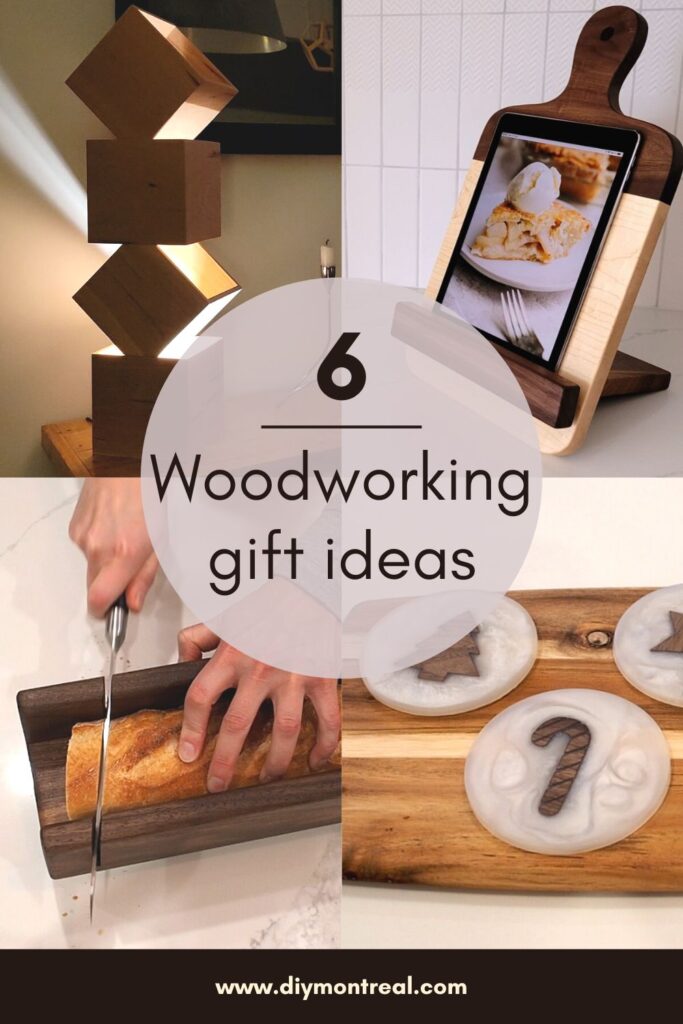Every year before the holidays, I make one of these gift making videos. I’ve gone through a lot of woodworking gift ideas over the years (you can watch all the previous editions here) but somehow I managed to come up with 6 brand new ideas to share with you this year.
Templates
6 Woodworking Gifts You Can Make
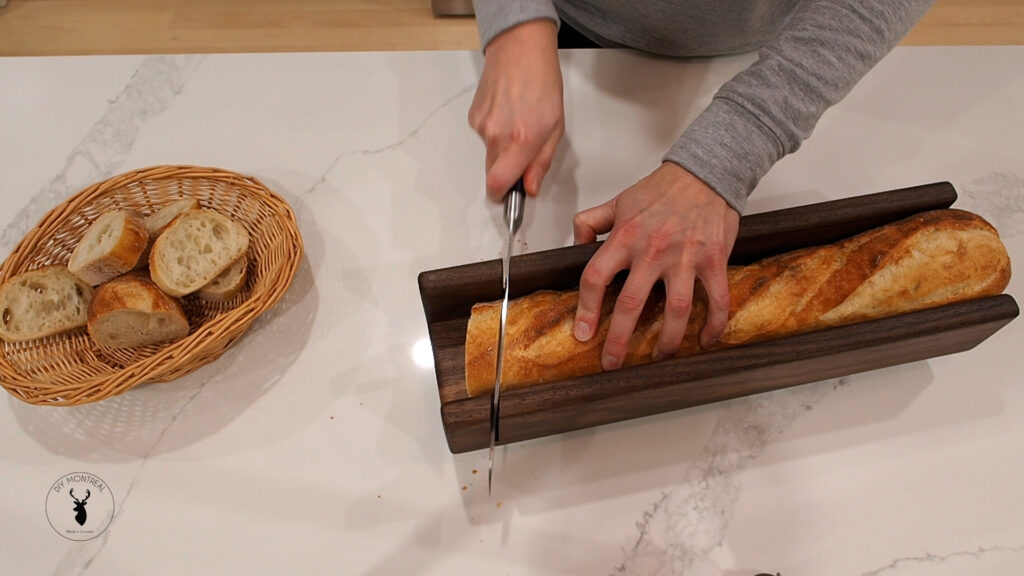
Gift Idea #1 – Easy Baguette Slicer
Tools & Materials Used
- 3/4-inch walnut
- Miter gauge https://amzn.to/3OlZWs3
- Clamps https://amzn.to/3hTIwqI
- Waterproof Glue https://amzn.to/3tGGflk
- Roundover bit https://amzn.to/3sElbLX
- Spray adhesive https://amzn.to/3Xar7u9
- Spindle sander https://amzn.to/3tHDD6L
- Center punch https://amzn.to/3sKyABW
- ⅜ dowel pins https://amzn.to/3AvN8tv
- Dowel jig https://amzn.to/3ghZjDv
- Drill block https://amzn.to/3ELbp1d
- Osmo Polyx-oil finish https://amzn.to/3tLQKUG
Dimensions (3/4 inch thick walnut)
- 3 x 16 – bottom
- 2-3/4 x 16 – sides (x2)
- 3 x 4 – block for feet (download template here)
How to Make an Easy Baguette Slicer
Kitchen items are always a big hit for handmade gifts, so here’s an original bread slicer to start things off. I have 3 pieces of walnut that I’ll cut 16 inches long.
With the 3 pieces cut, I’ll add some waterproof glue and assemble the pieces into a U-shape, then clamp and let it dry.
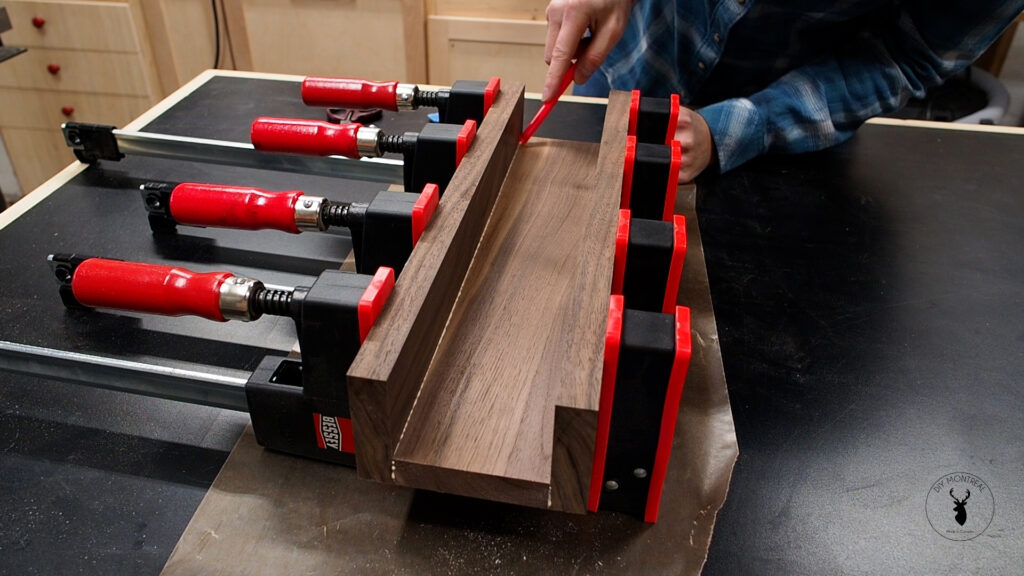
Once dry I’m going to round over all the edges to make it more comfortable to handle and it’ll just look better too. I’m using my router table but you can use a handheld router with a roundover bit just as well.
Next I want to cut a slot to guide the bread knife as it slices the bread. Instead of making it perpendicular, I want it at a slight angle, so I’ll rotate my miter gauge to 15 degrees. I’ll take several passes, raising the blade progressively until it skims the bottom, just barely cutting into it. I can then nudge it over a tiny bit and make another cut to widen the slot.
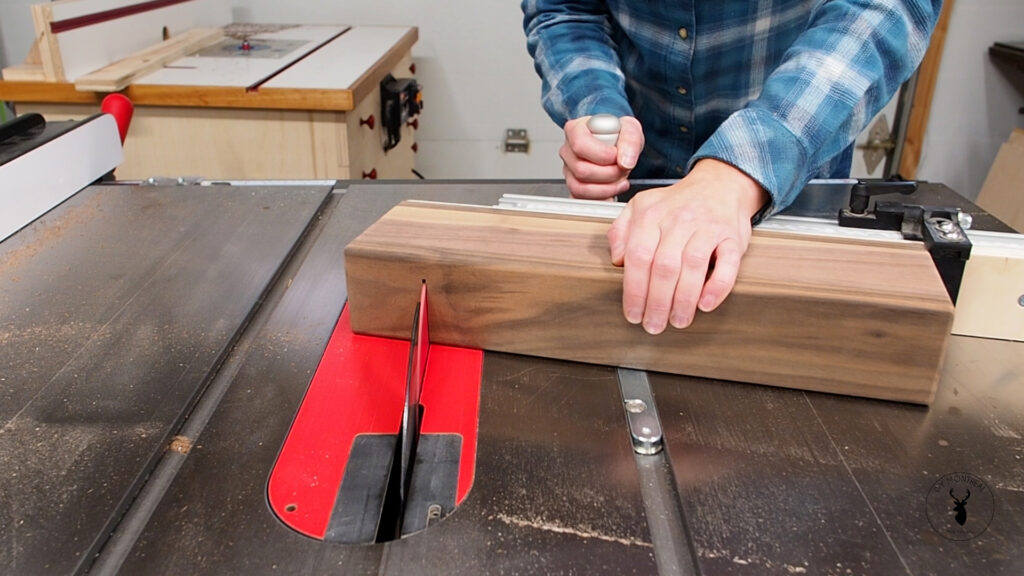
To complete this baguette slicer, I’ll add some feet. I designed these simple feet templates that you can download and print. Using light spray adhesive, I’ll secure them to a piece of walnut.
I can then take it over to the bandsaw to cut them out. After cutting out a rough shape I can refine it on the benchtop sander.
The feet will be attached with a couple of dowels. In hindsight, I think I could have just screwed them on from underneath.
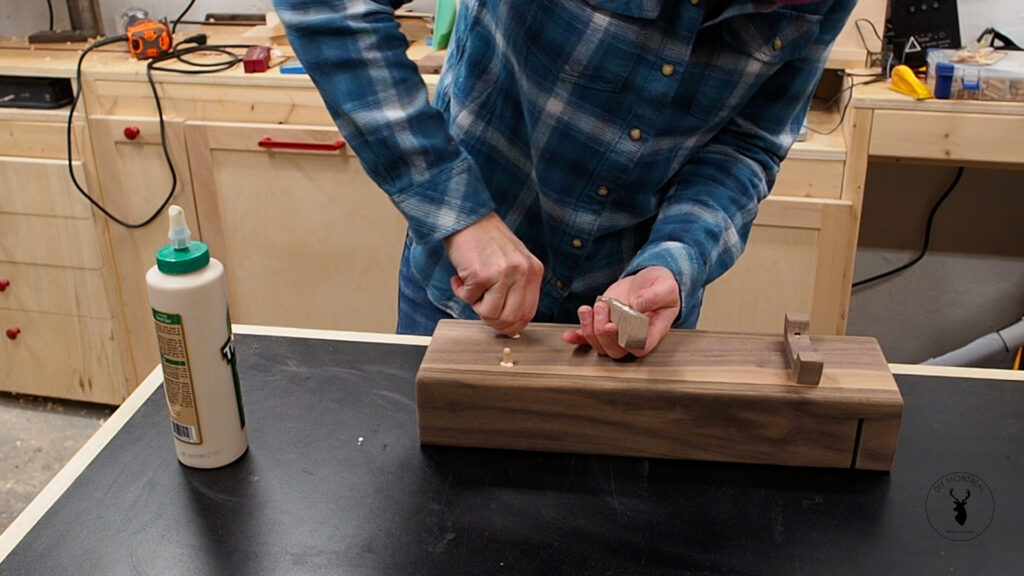
All that’s left is to apply a finish. I’ll first wipe off all the dust with a tack cloth, then apply 2 coats of Osmo Polyx-oil.
Now grab yourself a baguette and enjoy!
Gift Idea #2 – Bottle opener / Fridge Magnet / Coaster (3-in-1)
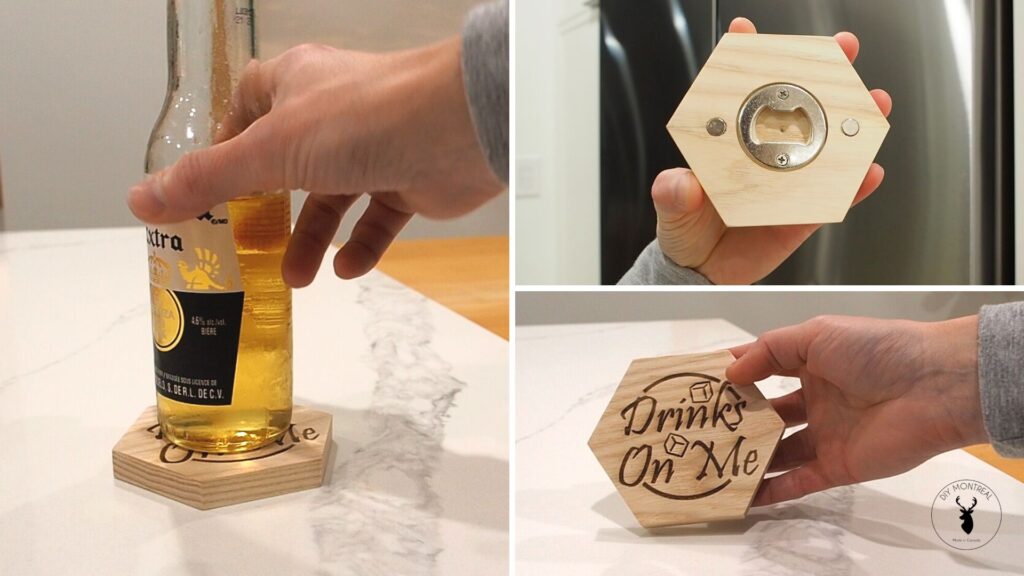
Tools & Materials Used
- ½-inch thick Ash wood
- Hexagon cutting jig https://youtu.be/CzTUOQZQoR0
- Bottle opener inserts https://amzn.to/3GsiEfV
- 3 x 8 mm rare earth magnets https://amzn.to/3Oi0D5S
- CA glue & activator https://amzn.to/3On9pPX
- Forstner bits https://amzn.to/3zuUltj
- Laser engraver https://amzn.to/3Xl2Em2
Dimensions
- Cut hexagon with 2-inch sides using this hexagon cutting jig https://youtu.be/CzTUOQZQoR0
- Drill shallow hole on center using 1-⅝ (or 40 mm) Forstner bit
- Drill deeper hole on center using 1-inch Fortner bit (careful not to poke through!)
- Drill 2 holes using 5/16 (or 8 mm) drill bit
How to make a 3-in-1 Hexagon Bottle Opener
This one is a fun easy project for all the beer lovers in your life.
Now, you can make this bottle opener any shape you want, but if you’ve watched any of my videos before, you’ll know I have a thing for hexagons. I built this hexagon cutting jig a while back that I’ll use to cut the hexagon shape. The cutting process is simple: basically just cut, rotate, and repeat until you have a hexagon.
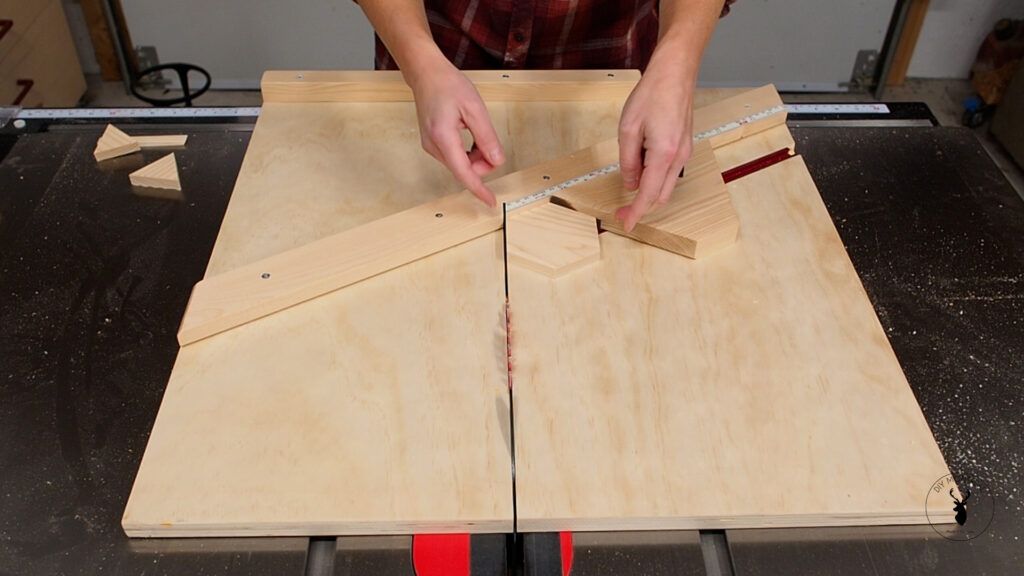
The idea is to insert a flat bottle opener insert right in the middle. I’ll connect the opposite corners of the hexagon to find the exact center. Next I’ll mark the spot for 2 magnets on one of the lines, roughly 2 cm from the edge on each side. I used a center punch to better guide the drill bits in the next steps.
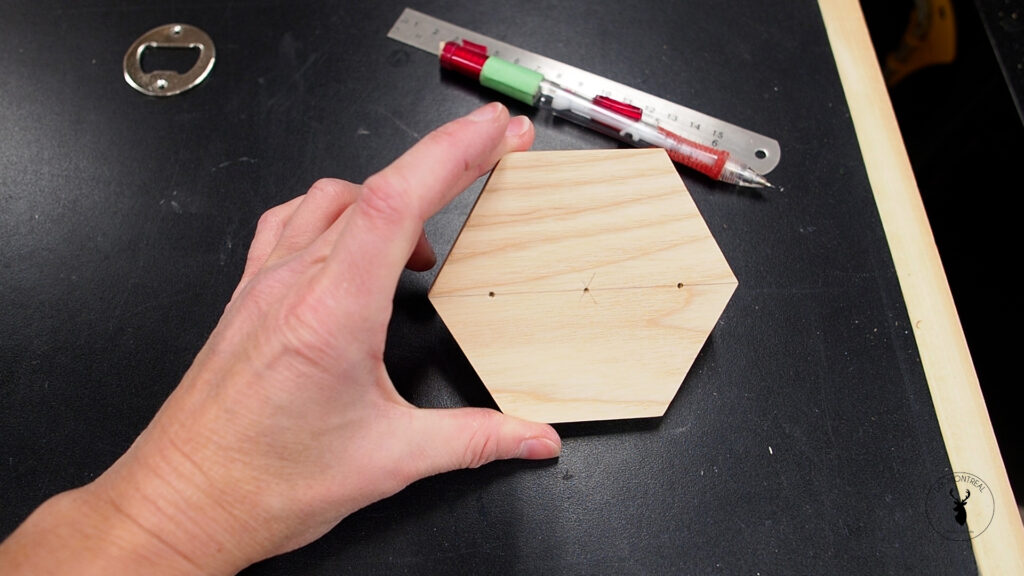
Over at the drill press I’ll start with a larger Forstner bit and make a very shallow hole. The closest bit size I have is 1-⅝ but you can invest in a 40 mm bit if you plan to batch a lot of these out.
After testing that the insert fits (flush to the surface or just under), I’ll switch to a 1-inch Forstner bit and drill as deep as I can without poking through. It’s a good idea to practice on some scraps first to dial in the settings.
Lastly, I’ll drill the holes for the rare earth magnets using a 5/16″ or 8 mm drill bit – just shallow enough so the magnets will be flush with the surface.
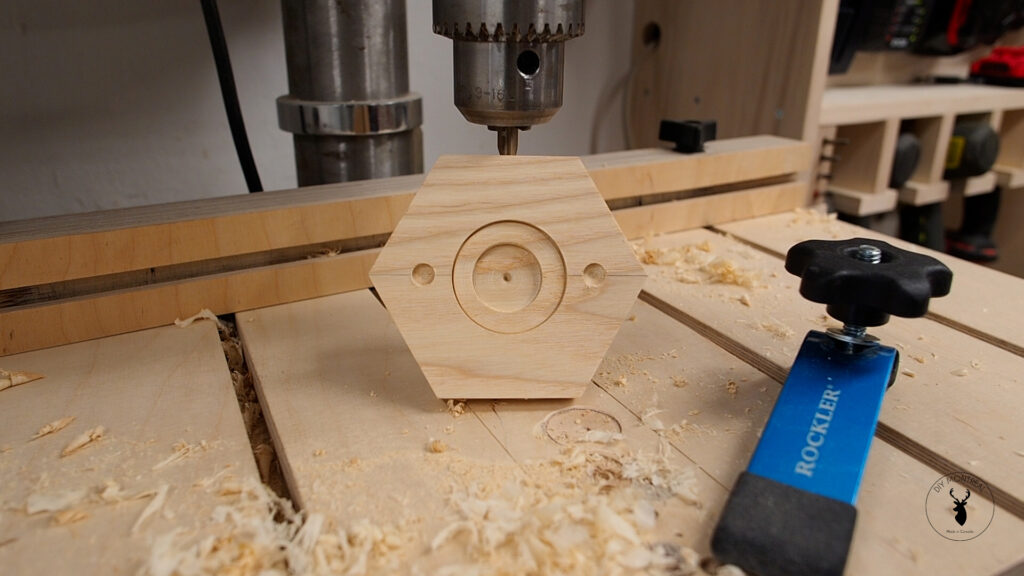
To secure the magnets, I’ll apply a dab of CA glue in the holes, and spray activator on the magnets before dropping them in.
I’ll use a little more CA glue, then drop in the insert, and secure it with the provided screws.
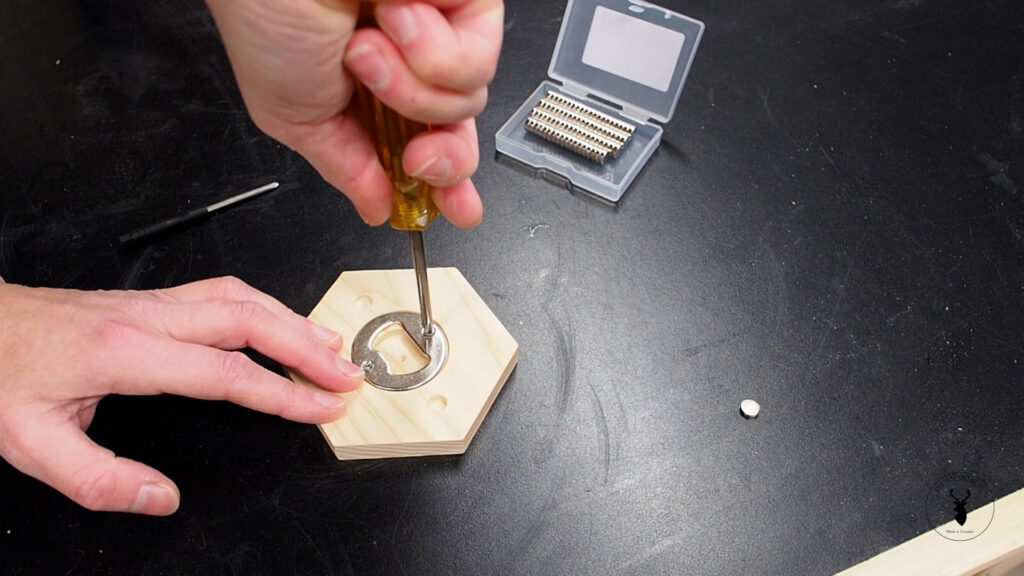
Now you could stop there but I got myself an early Christmas present that I couldn’t resist trying out. I designed a simple little logo and used my new laser to engrave the bottle opener. I think it came out pretty nice!
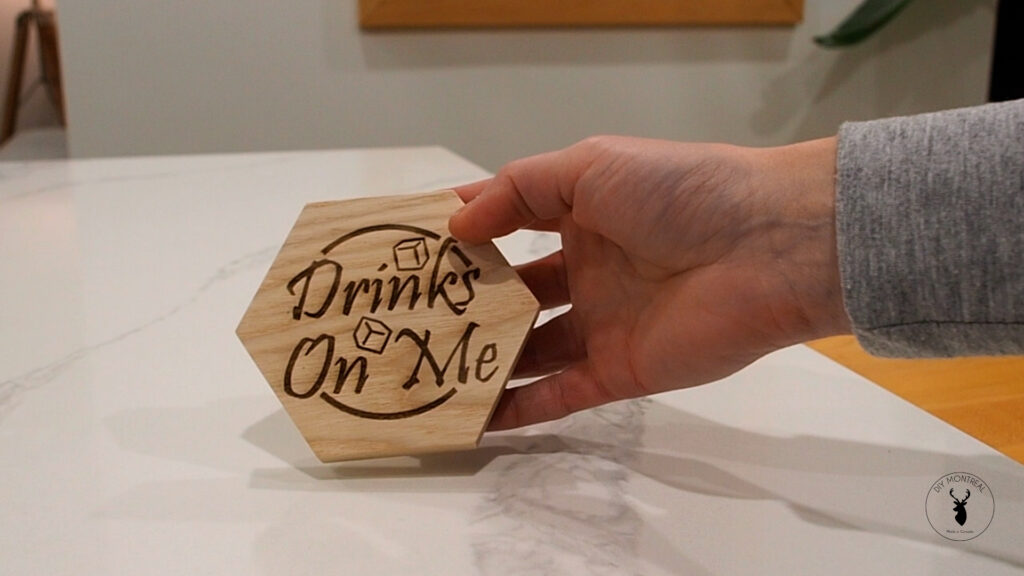
Now all that’s left is to pop open a cold one, and enjoy! It’s a bottle opener, it’s a fridge magnet and coaster all in one.
Gift Idea #3 – Festive Holiday Coasters
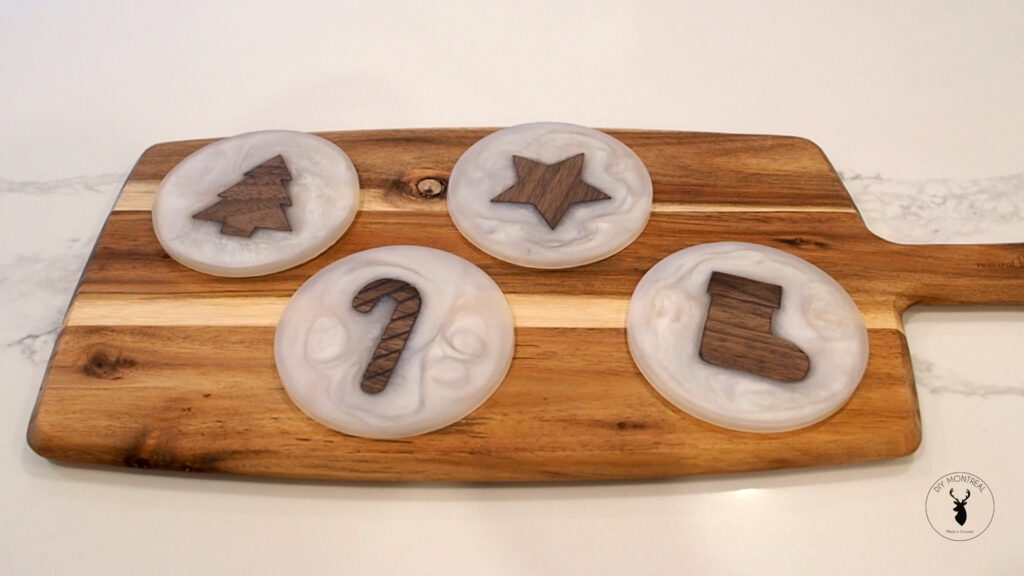
Tools & Materials Used
- Spray adhesive https://amzn.to/3Xar7u9
- Coaster round molds https://amzn.to/3ghZGhn
- Epoxy resin https://amzn.to/3EkKc4g
- White metallic pigment https://amzn.to/3ELBz3Z
- Epoxy mixing cup https://amzn.to/3AvME6C
- Flush trim saw https://amzn.to/3XtDrG7
- Sandpaper cleaning block https://amzn.to/3V5q8t6
- Osmo Polyx-oil finish https://amzn.to/3tLQKUG
Use this template to cut out the holiday shapes using 1/2-inch walnut
How to Make Wood & Epoxy Holiday Coasters
Next we’re getting festive with some unique holiday coasters. The coasters will be made of epoxy and feature wooden holiday shapes in the center. I really love the contrast of the snow white epoxy with the walnut wood.
I’ll start with a thin piece of walnut, no more than half an inch thick. I created a few holiday inspired shapes that I printed out. You download and print the free template here. I’ll use some light spray adhesive to tack down the template so I can then cut the shapes out on the bandsaw. Since the bandsaw leaves ridges along the edges, I’ll do a little sanding to clean up the shapes.
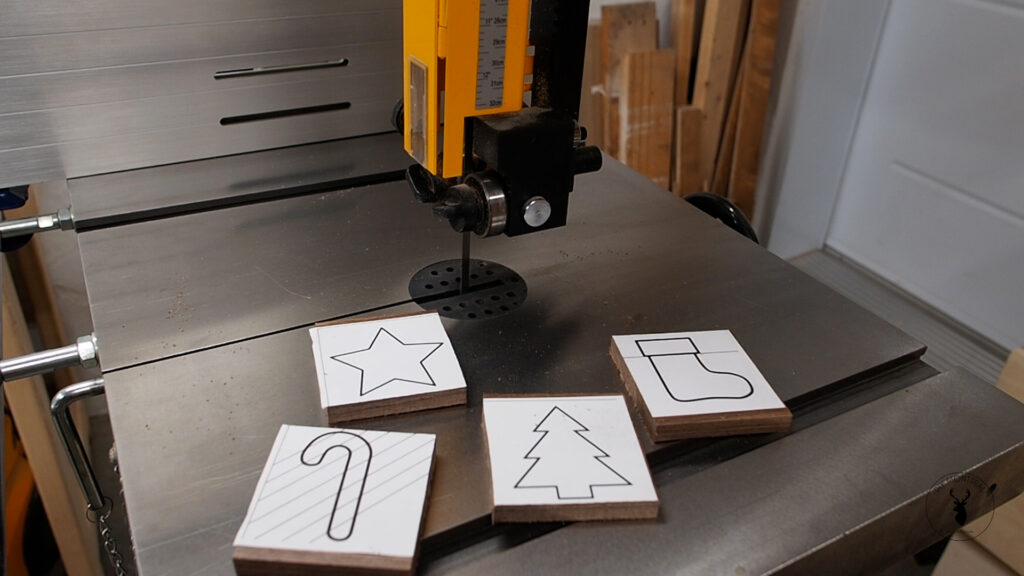
You’ll notice lines on the templates on top of the shapes. I mean, you can’t have a candy cane without stripes, right? The idea is to use a small saw to cut on the lines and create a bit of a 3D effect.
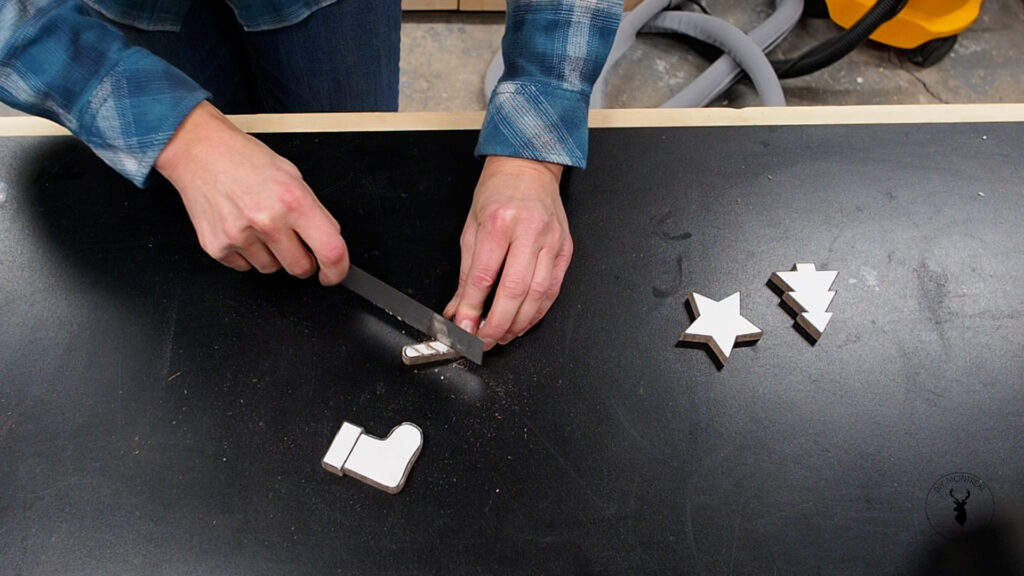
Alright, with that done, it’s time to pour these coasters. I’ll use these silicone molds, my shapes and some fast curing epoxy. Oh and of course some white pigment for a winter snow effect.
Working with epoxy isn’t as hard as you think. Just mix both parts in a mixing cup – in this case 2 parts A and one part B – then mix it up. I can then add my white metallic pigment, and then maybe add some more, until I’m happy with the color.
I’ll first pour a thin base then drop in the shapes face down and move them around a little to make sure no air pockets get trapped in those lines I cut. I can then top them up with more epoxy, but no need to go all the way to the top of the shapes. We’ll be sanding those down later.
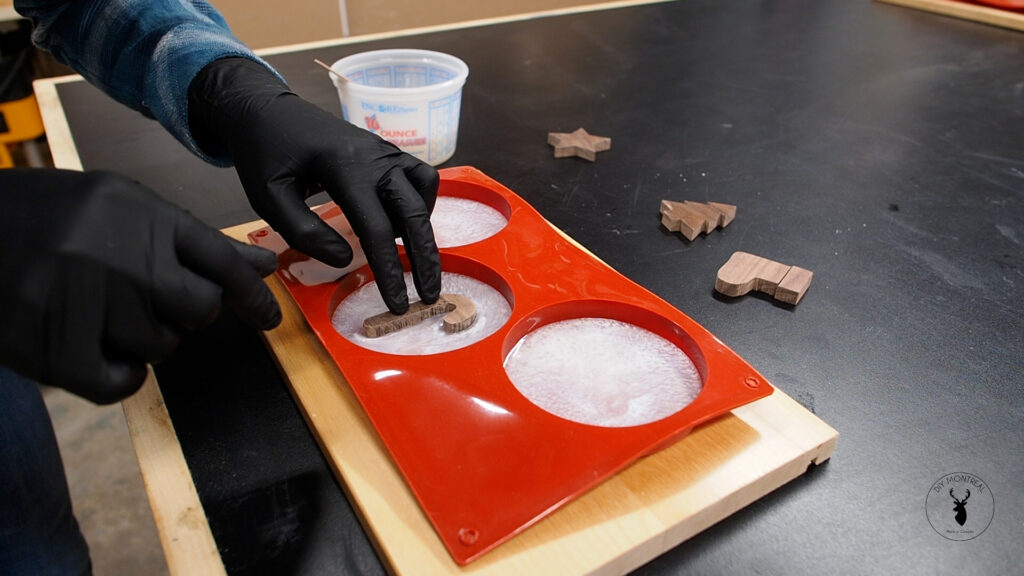
The wood will want to float around in the epoxy so I found some weights that I’ll use to hold them in place until the epoxy cures. Anything plastic is a good option for this.
The next day, I can easily pop them out. I want to get them all down to the same thickness, about a quarter inch. I’ll use some scraps to make a simple sanding jig using quarter inch plywood that’ll surround the coaters and hold it in place while I sand them. This also happens to be the same thickness that I’m aiming for my coaster to be, which means I can just keep sanding, feeling the edges as I go, until my sander bottoms out. I’m using 60-grit paper to really grind these down quickly. Just be careful that you don’t overheat the resin or the shape might become deformed.
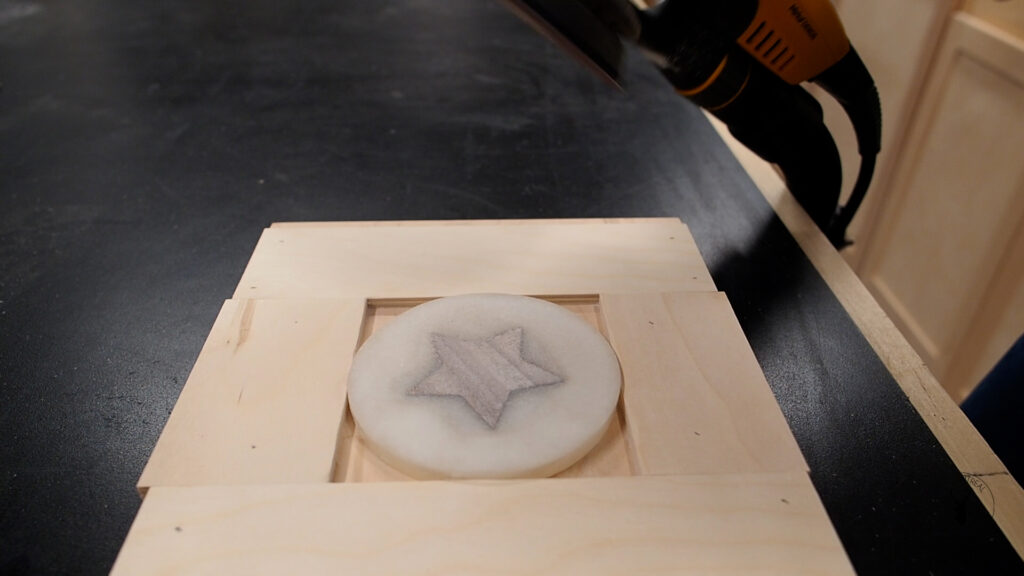
Once all four are done, they should all be even in thickness. They’re looking pretty rough, so as a final touch, I’ll polish them up. I’ve set up a series of grits from 120 to 180 to 220 to 320 and finally 400-grit.
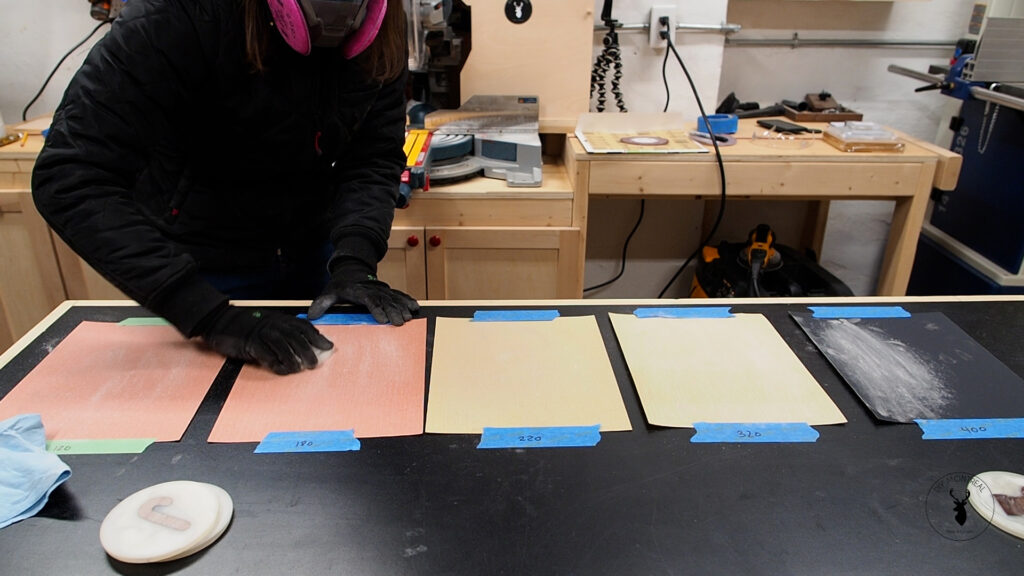
All that’s left is to add some finish. I’m again using Osmo Polyx-oil which is a fast and easy wipe on finish that’ll leave a smooth silky finish.
Let the finish dry and enjoy!
Gift Idea #4 – Floating Cube Tower Lamp
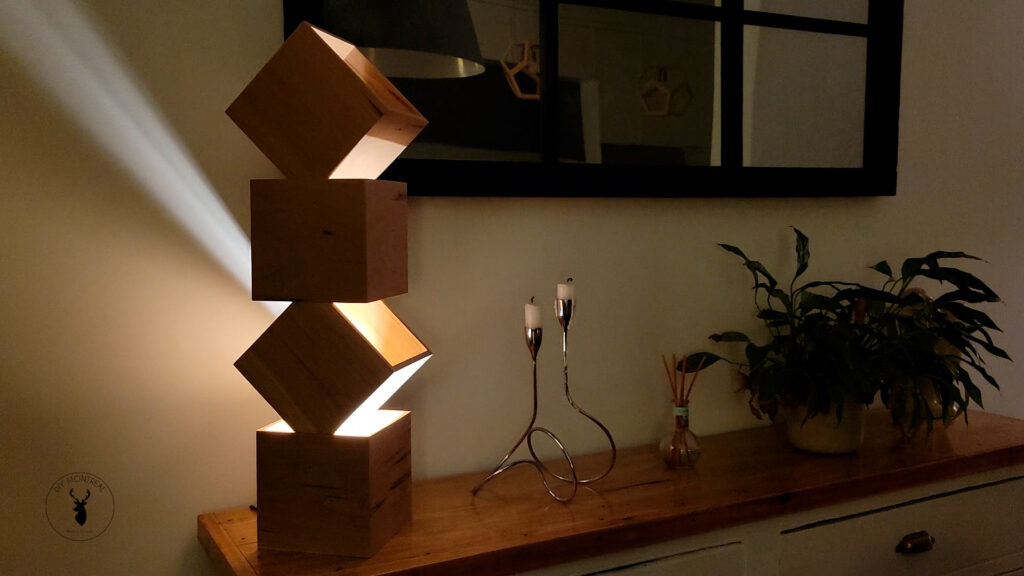
Tools & Materials Used
- Cherry wood
- Push block https://amzn.to/3GqkRsd
- 45 degree crosscut sled https://youtu.be/S5qstSsiExA
- Painter’s tape https://amzn.to/3TPz2tO
- Gorilla glue https://amzn.to/3EKw9pN
- CA glue & activator https://amzn.to/3On9pPX
- LED Puck light https://amzn.to/3hVNJym
Dimensions (5/16-inch thick cherry wood)
- 5-½ x 5-½ with miters on 2 opposing ends (x16)
- Assemble into 4 open cubes (4 pieces per cube)
- Cut a bottom panel to fit within the bottom cube then drill hole towards one side using a ⅜ Forstner bit
How to Build a Floating Cube Tower Lamp
This next gift idea was inspired by a design I saw online that looked like a tower of floating cubes with light beaming up the tower from the base.
The construction is pretty simple: just make 4 open cubes and pile them up. I don’t want it to be too chunky so I’m resawing some cherry wood into thinner pieces which I’ll then clean up with the planer.
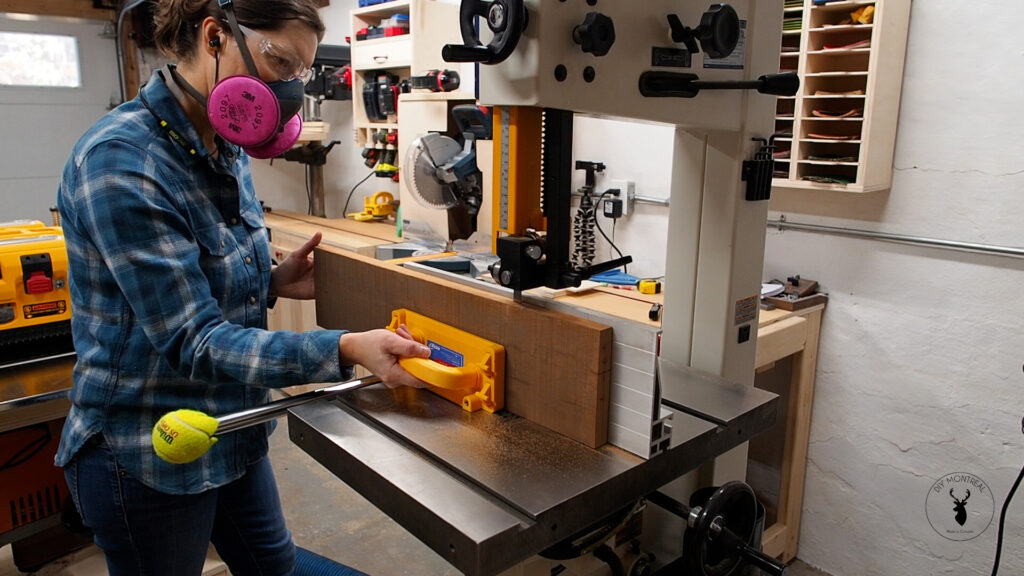
I’m going to create miter joints to assemble the boxes, so I’ll start by tilting my blade to 45 degrees. Foar safer and cleaner cuts, I’m going to use a 45 degree crosscut sled. It’s basically a regular crosscut sled but dedicated to cutting long miters or bevels.
I’ll first trim one edge off all of my boards to create a reference edge. I can then set up a stop block so I can cut every single piece to the same length and end up with 16 identical pieces.
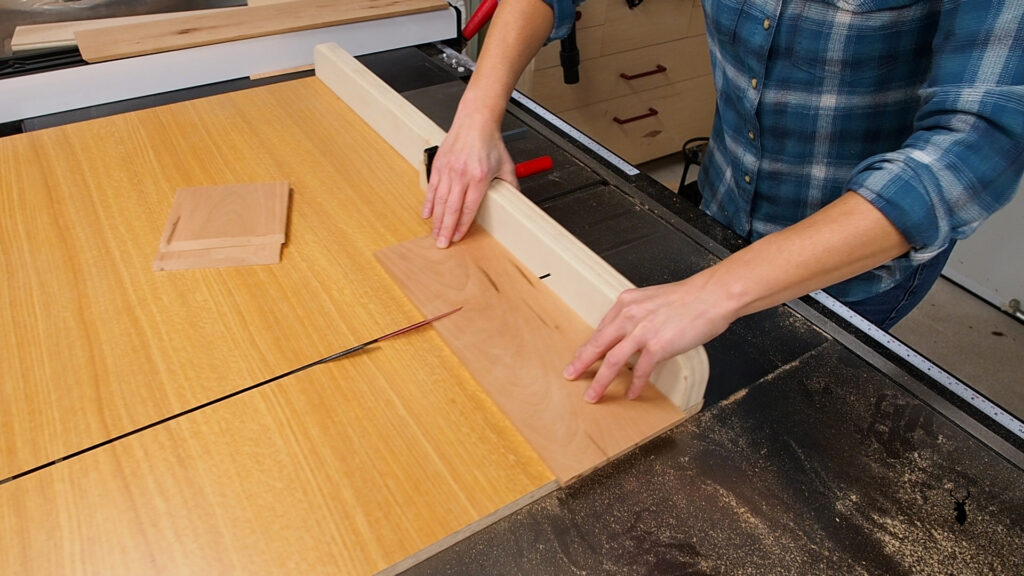
With all my pieces cut, it’s time to assemble the cubes. The easiest way I’ve found to do this is to lay it all flat, edge to edge, using some painter’s tape to connect the edges. I’ll then apply glue to the joints, and fold it up into a cube. Note that the bottom cube gets a small lip that will support a floating bottom panel later on.
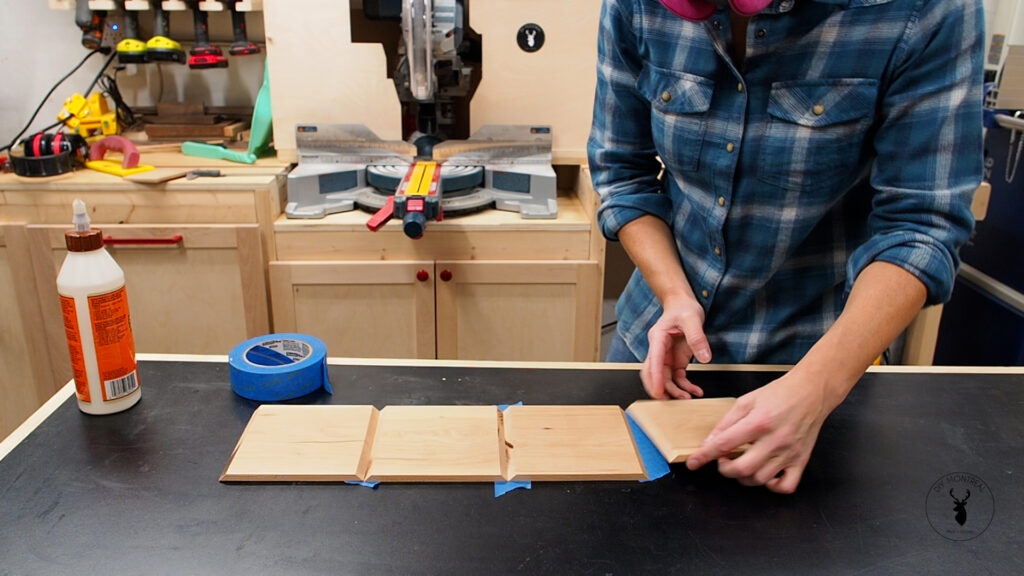
Okay, now we’re getting to the tower part. With my blade still set at 45, I’ll gently run the cube through to cut off the corner. Both opposite corners should be cut from the middle cube and one corner of the top cube.
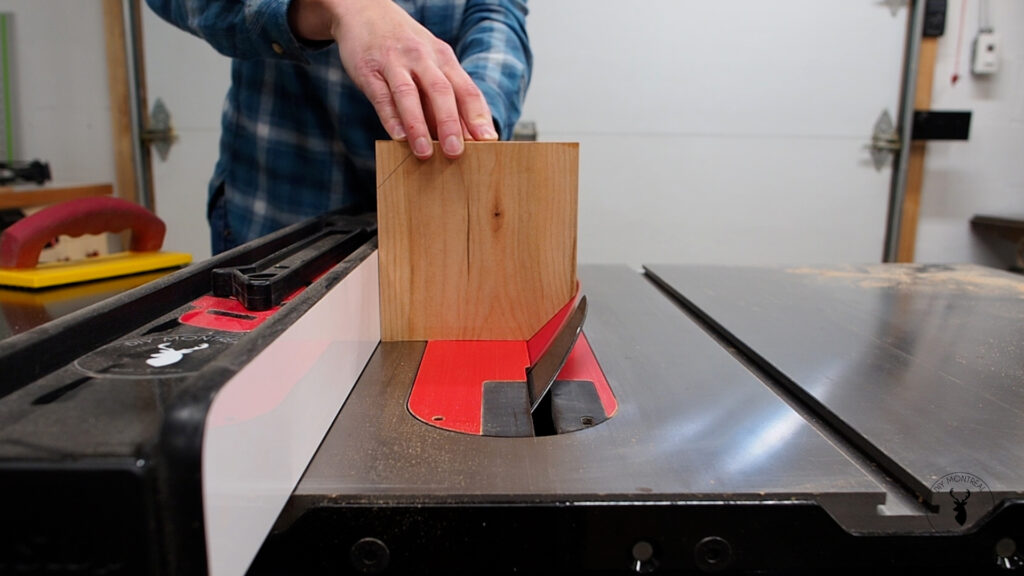
Last but not least, it’s time to add the light source. I cut a panel to fit the bottom cube and drilled a medium hole to be able to thread the wiring.
I’ll be using an LED puck light that’s probably meant to be used as cabinet lighting, but it’ll work. It has a toggle switch which will be perfect for a lamp. I’ll just secure it on-center with the provided screws then screw the cover back on to seal it up, and thread the wire through the hole.
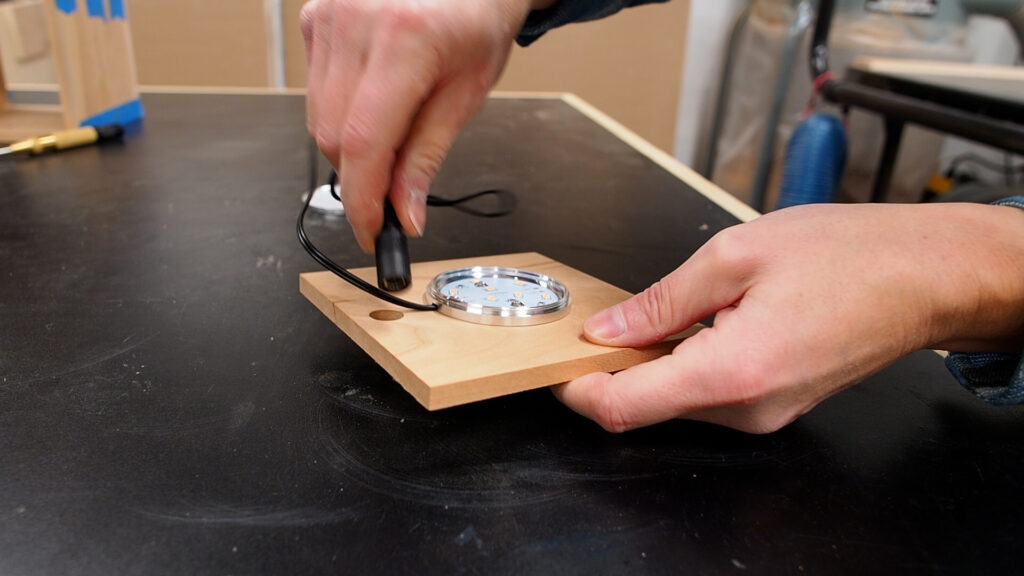
One last thing is to make a small notch for the wire in the bottom cube by just running it through the table saw.
Now I can drop in the panel and assemble this lamp. Just a few dabs of glue and a careful balancing act to build up the tower.
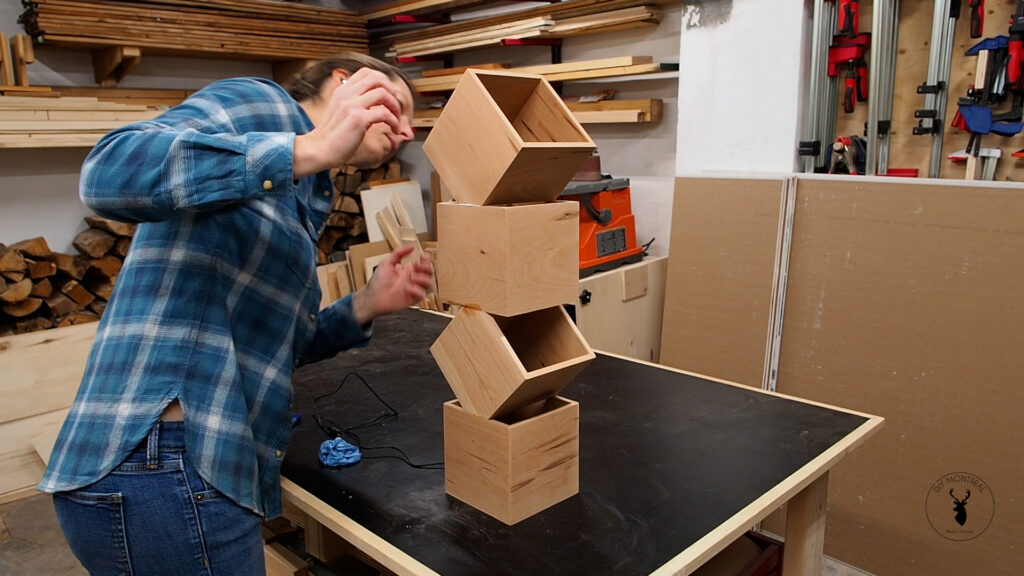
I’m leaving it raw, but you can easily remove the bottom panel and apply a spray finish if you want.
Okay, let’s light it up!
Gift Idea #5 – Cookbook / iPad Stand
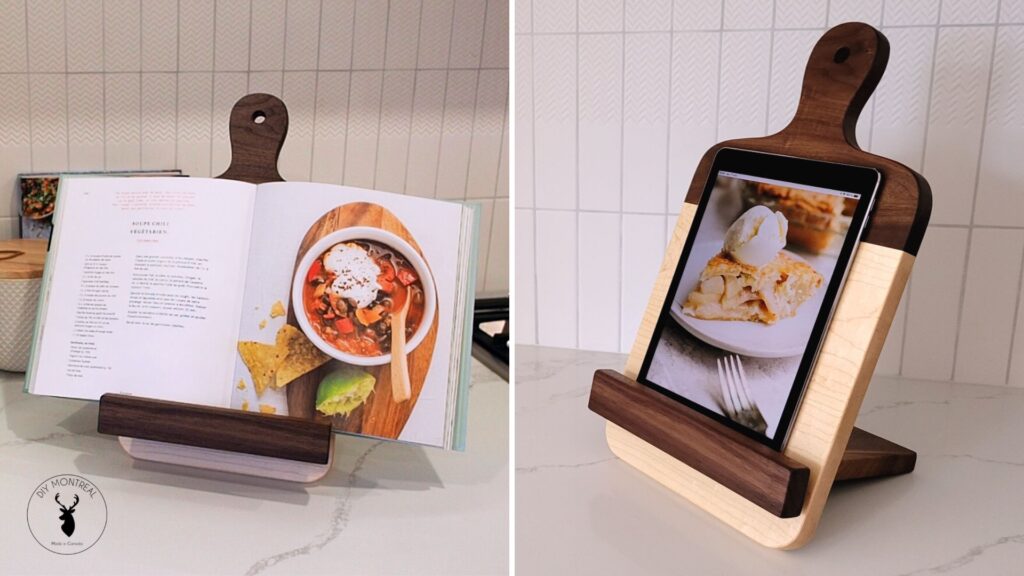
Tools & Materials Used
- Walnut & Maple
- Waterproof glue https://amzn.to/3tGGflk
- Clamps https://amzn.to/3hTIwqI
- Spray adhesive https://amzn.to/3Xar7u9
- Trim router https://amzn.to/3WgFwoc
- Up-spiral bit https://amzn.to/3TQ8Mj4
- Roundover bit https://amzn.to/3sElbLX
- Doweling jig https://amzn.to/3ghZjDv
- Dowels https://amzn.to/3AvN8tv
- Forstner bits https://amzn.to/3zuUltj
- Osmo polyx-oil finish https://amzn.to/3tLQKUG
Dimensions (¾-inch thick walnut and maple)
- Assemble a blank that’s roughly 16 x 9
- Use this template to cut out the handle shape
- Cut a slot ⅞ wide that’s 1-½ from the bottom edge and 6-½ long
- Drill hole into handle using a 1/2″ Forstner bit
- Stand parts: 8 x 5-½, 9 x 1-½
- Assemble stand parts above into a T-shape, flush on the bottom side
How to Make a Cookbook / iPad Stand
If anyone on your Christmas list loves to cook, this one’s for you. I’m making a collapsible cookbook / iPad stand that can also be used as a serving board.
I cut up some walnut and some maple, and found a layout that I liked. It should be roughly 16 inches long by 9 inches wide, give or take.
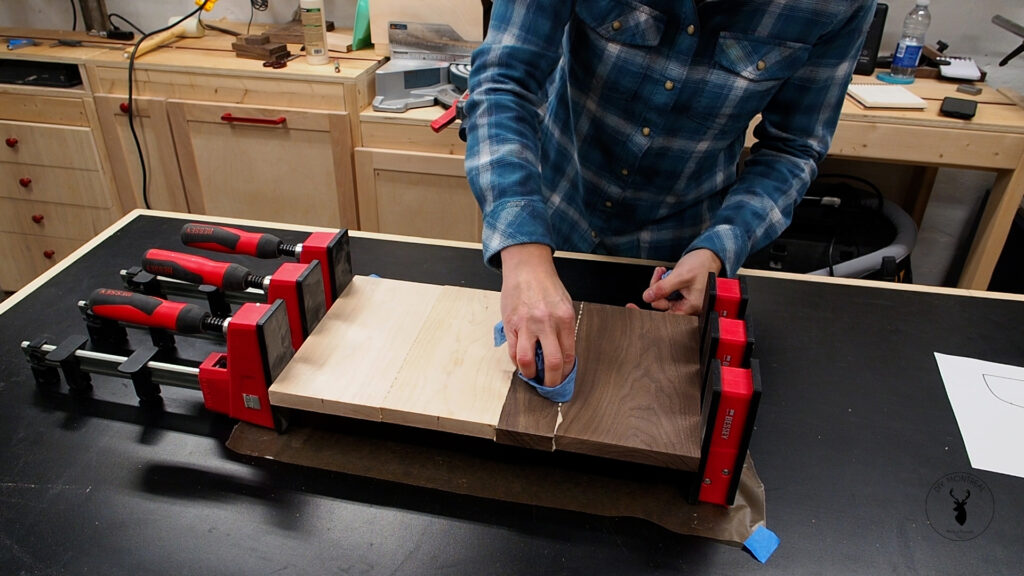
Just like making a cutting board, I’ll apply a generous amount of glue to the seams and clamp them all together. I won’t be using my planer for this so I made sure to wipe away all the glue with a damp rag. Once dry, I sanded with 80-grit just to get the faces flat.
I designed this cutting board handle on the computer to make a printable template that you can download for free here. Using some light spray adhesive, I’ll secure the template to the wood, and press it down. I’m using this radius jig to round the bottom corners, but you can use any circular object you have on hand, like a bottle cap or whatever.
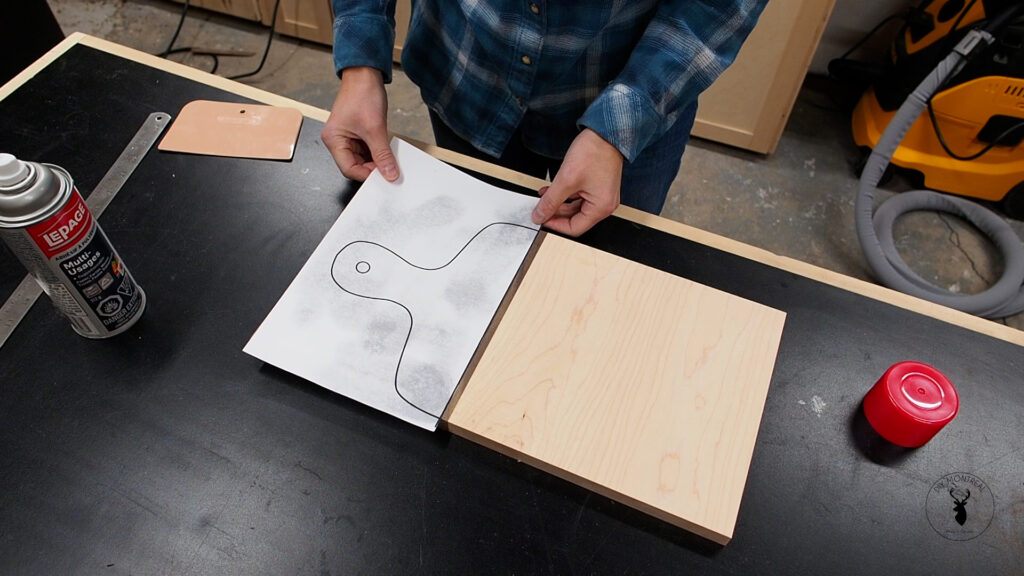
I’ll use my bandsaw to cut out the handle but a jigsaw would work just as well. For now I’ll stay outside the lines and finish refining the shape on the benchtop sander.
Before removing the template, I’ll use a 1/2-inch Fortner bit to drill the hole in the handle.
Moving onto the other half of this stand, I’m going to attach 2 pieces of walnut into a T-shape. But first, I want to break all these sharp edges so I’ll round over all the edges on the router table. To assemble them, I’ll use some dowels.
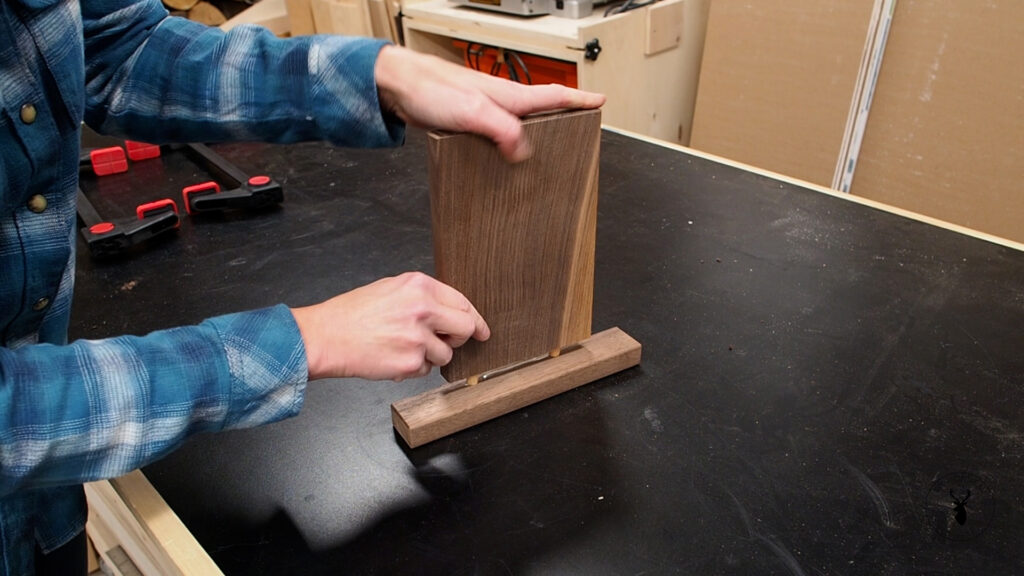
The last step is to cut a slot in the board to fit the stand. First I’ll roughly mark the width of the slot, then use those as a reference to trace out the slot. I’ll use a Forstner bit at each end and drill all the way though. Next I’ll switch to a smaller bit and remove most of the waste, while staying inside the lines.
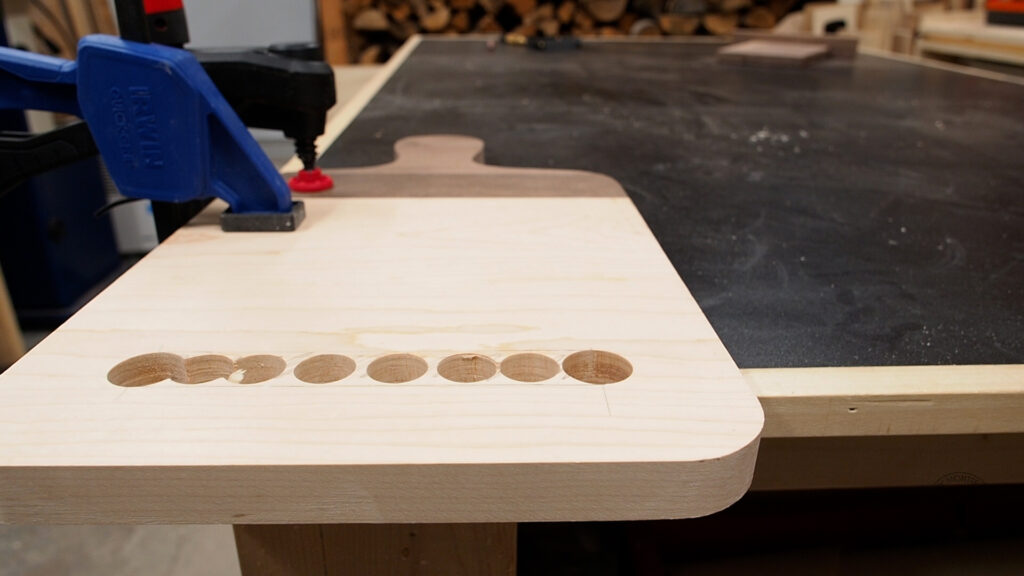
I can now use a router with a guide and an up-spiral bit to finish cutting out the slot. I’ll push the bit up against one side, then lock down the guide rail. Now I can fire up the router and run it along the first side, then progressively lower the bit, and run it again until I’m all the way though. Then repeat the same process on the other side. And voilà, a perfect slot.
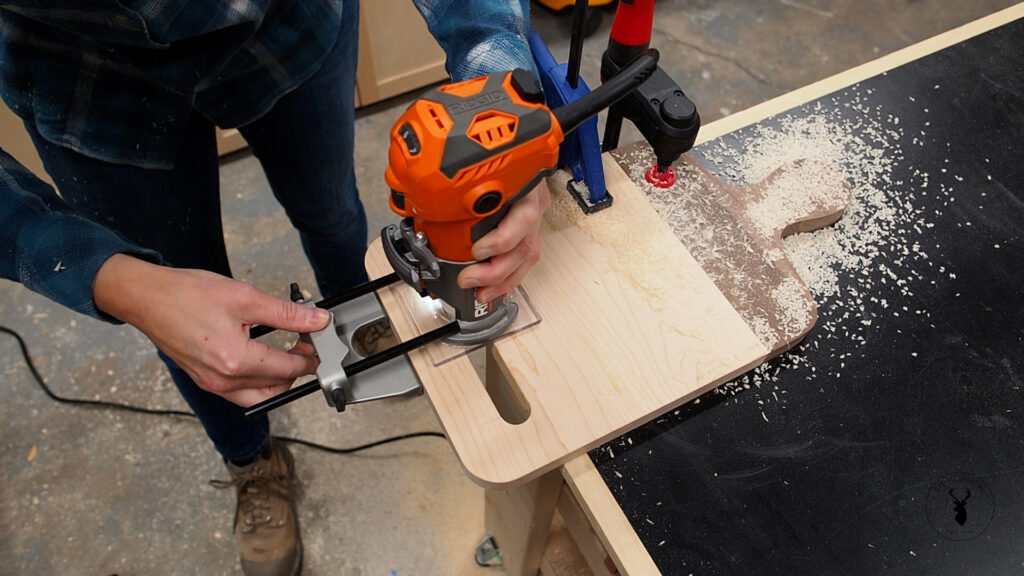
All that’s left are the finishing touches, like rounding over all the edges, sanding, and applying a finish. Again I’m using Omso polyx-oil just because it’s a no-brainer wipe-on finish that’s low VOC and can be done in a single day.
Now find your favorite recipe, and enjoy!
Gift Idea #6 – Wooden Bookmarks
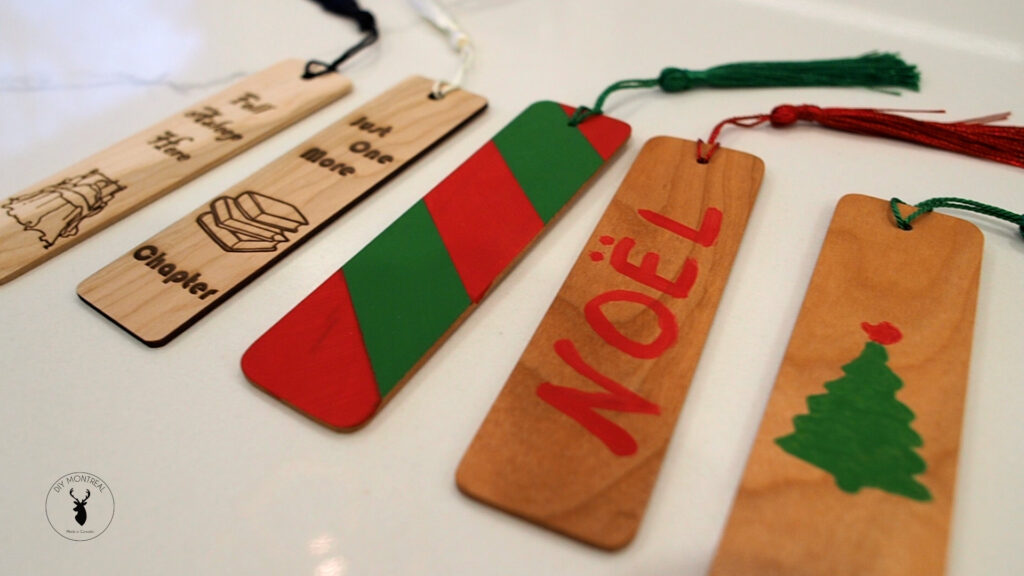
Tools & Materials Used
- Double-sided tape https://amzn.to/3FoXxuq
- Digital calipers https://amzn.to/3ggs8Aj
- Grr-ripper push block https://amzn.to/3AtsMRJ
- Shellac https://amzn.to/3XjBuvN
- Acrylic paint https://amzn.to/3XdO5jY
- Tassels https://amzn.to/3gqY3hc
Dimensions (3 mm thick cherry wood)
- 1-¼ x 4-¾ bookmarks
Easy DIY Wooden Bookmarks
The next one is really simple, but if you want to give a little handmade something to a lot of people in your life, this one might be right up your alley.
For this you’ll want really thin wood, like no more than 3 mm. You can use plywood, but I wanted to try using solid wood, so I resawed some thin pieces on the bandsaw.
The bandsaw leaves rough marks and my pieces aren’t even in thickness, but I can’t run these pieces like this through the planer. They’re just too thin. A simple trick is to use a piece of particle board and stick down the pieces with some double-sided tape. Now I can run the board though until both pieces are even and smooth. Just be careful pulling them up because you can easily crack them.
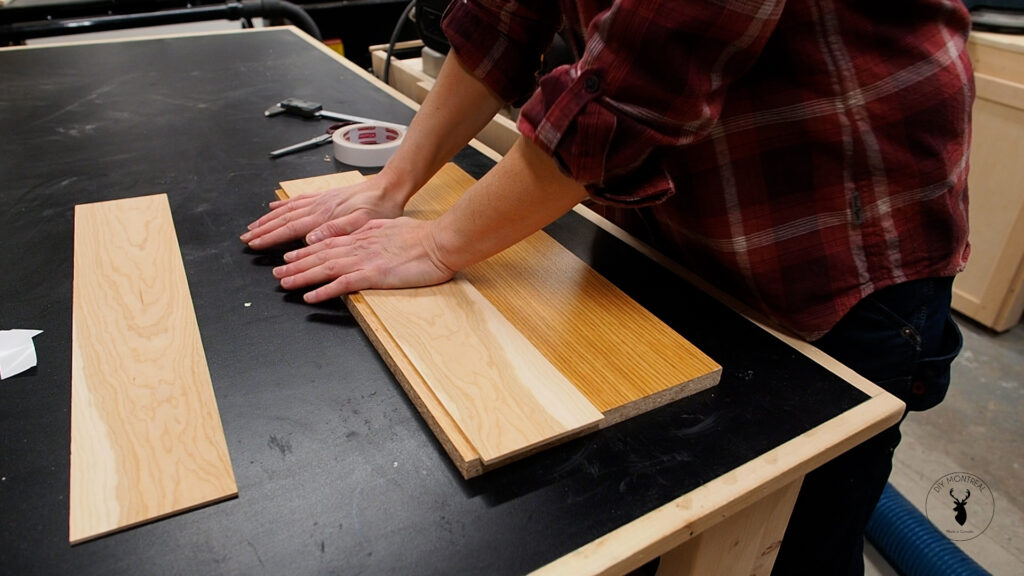
This wood is so thin that I thought of cutting it with a utility knife, but that was taking forever, so I decided to use the table saw after all. I was careful to use a push block like this one to make these cuts safely. I’ll first cut long strips that are roughly 1-1/4-inch wide.
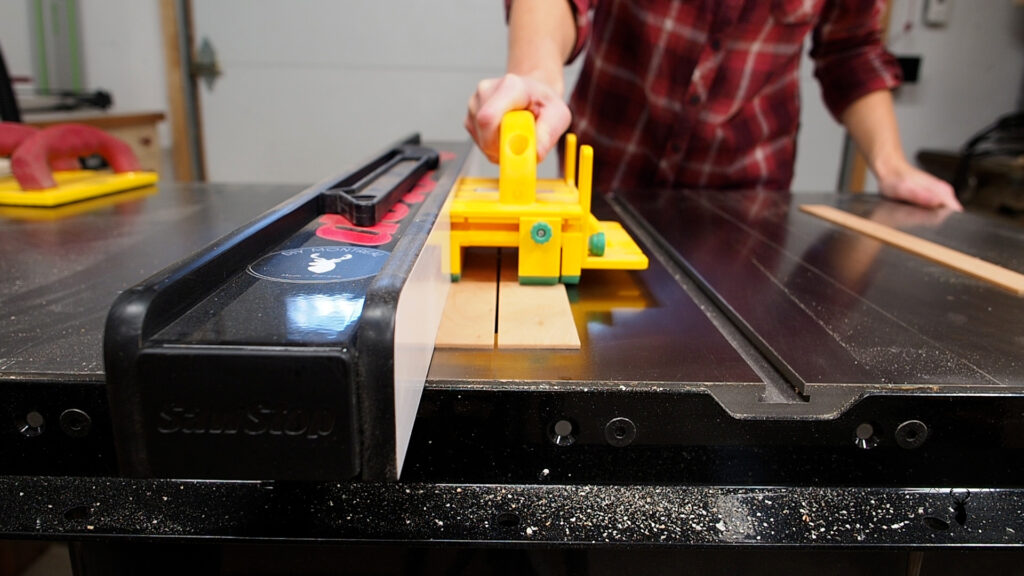
Next, I taped the pieces together to make the following steps much faster than shaping them all one by one.
I used my small crosscut sled to cut them to length (4-3/4 inch), and then used the sander to round all the corners. And lastly, I made a small hole at the top. And a little light sanding to remove any fuzzies.
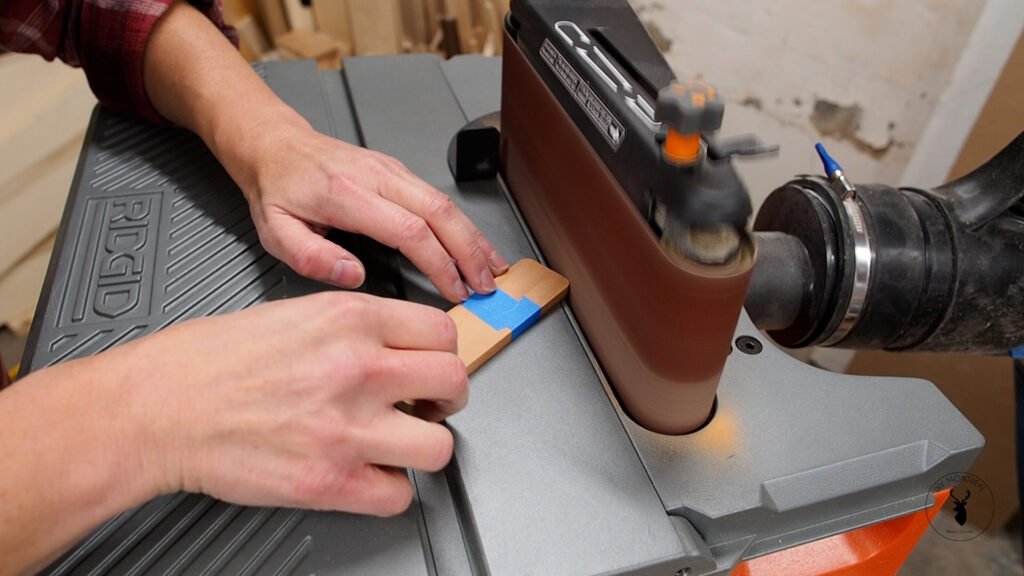
You can decorate these however you want. If you’re going to paint them, I recommend first applying a coat of shellac to seal the wood. This should help to prevent any bleeding if you’re masking off sections with tape.
So have fun with it! You can use some masking tape to create a candy cane effect using acrylic crafts paint. I used my laser engraver to make a few original designs as well for all the bookworms in my life.
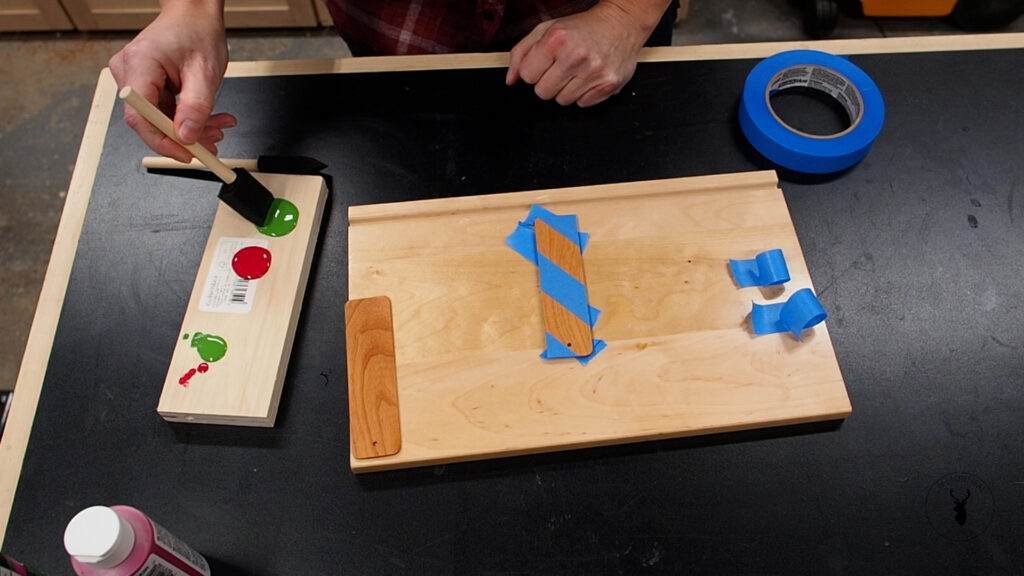
Now just add some tassels, and voilà!
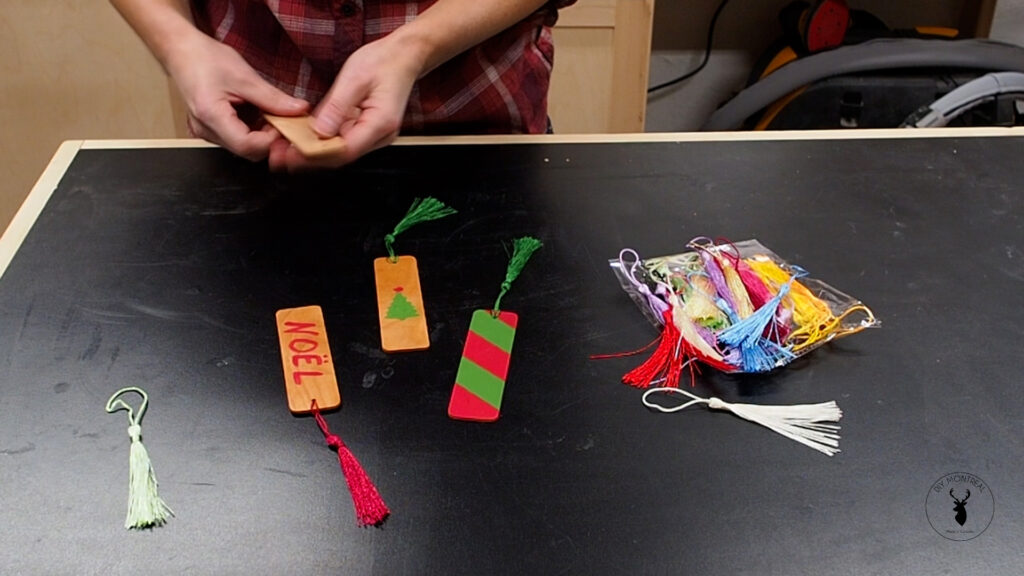
Hopefully you found some inspiration for your Christmas list. Here are some of my previous gift making videos that you can check out for even more ideas.
Happy gift making and happy holidays!
